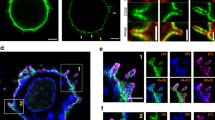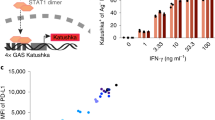Abstract
Induction of immunity and peripheral tolerance requires contacts between antigen-bearing dendritic cells (DCs) and cognate T cells. Using real-time two-photon microscopy, we have analyzed the dynamics of CD8+ T cells in lymph nodes during the induction of antigen-specific immunity or tolerance. At 15–20 h after the induction of immunity, T cells stopped moving and established prolonged interactions with DCs. In tolerogenic conditions, despite effective initial T cell activation and proliferation, naive T cells remained motile and established serial brief contacts with multiple DCs. Thus, stable DC–T cell interactions occur during the induction of priming, whereas brief contacts may contribute to the induction of T cell tolerance.
This is a preview of subscription content, access via your institution
Access options
Subscribe to this journal
Receive 12 print issues and online access
$209.00 per year
only $17.42 per issue
Buy this article
- Purchase on Springer Link
- Instant access to full article PDF
Prices may be subject to local taxes which are calculated during checkout





Similar content being viewed by others
References
Steinman, R.M., Hawiger, D. & Nussenzweig, M.C. Tolerogenic dendritic cells. Annu. Rev. Immunol. 21, 685–711 (2003).
Bonifaz, L. et al. Efficient targeting of protein antigen to the dendritic cell receptor DEC-205 in the steady state leads to antigen presentation on major histocompatibility complex class I products and peripheral CD8+ T cell tolerance. J. Exp. Med. 196, 1627–1638 (2002).
Probst, H.C., Lagnel, J., Kollias, G. & van den Broek, M. Inducible transgenic mice reveal resting dendritic cells as potent inducers of CD8+ T cell tolerance. Immunity 18, 713–720 (2003).
Bajenoff, M., Granjeaud, S. & Guerder, S. The strategy of T cell antigen-presenting cell encounter in antigen-draining lymph nodes revealed by imaging of initial T cell activation. J. Exp. Med. 198, 715–24 (2003).
Stoll, S., Delon, J., Brotz, T.M. & Germain, R.N. Dynamic imaging of T cell-dendritic cell interactions in lymph nodes. Science 296, 1873–1876 (2002).
Miller, M.J., Hejazi, A.S., Wei, S.H., Cahalan, M.D. & Parker, I. T cell repertoire scanning is promoted by dynamic dendritic cell behavior and random T cell motility in the lymph node. Proc. Natl. Acad. Sci. USA 101, 998–1003 (2004).
Miller, M.J., Wei, S.H., Cahalan, M.D. & Parker, I. Autonomous T cell trafficking examined in vivo with intravital two-photon microscopy. Proc. Natl. Acad. Sci. USA 100, 2604–2609 (2003).
Miller, M.J., Wei, S.H., Parker, I. & Cahalan, M.D. Two-photon imaging of lymphocyte motility and antigen response in intact lymph node. Science 296, 1869–1873 (2002).
Mempel, T.R., Henrickson, S.E. & Von Andrian, U.H. T-cell priming by dendritic cells in lymph nodes occurs in three distinct phases. Nature 427, 154–159 (2004).
Bousso, P. & Robey, E. Dynamics of CD8+ T cell priming by dendritic cells in intact lymph nodes. Nat. Immunol. 4, 579–585 (2003).
Gunzer, M. et al. Antigen presentation in extracellular matrix: interactions of T cells with dendritic cells are dynamic, short lived, and sequential. Immunity 13, 323–332 (2000).
Benvenuti, F. et al. Dendritic cell maturation controls adhesion, synapse formation, and the duration of the interactions with naive T lymphocytes. J. Immunol. 172, 292–301 (2004).
Bonifaz, L.C. et al. In vivo targeting of antigens to maturing dendritic cells via the DEC-205 receptor improves T cell vaccination. J. Exp. Med. 199, 815–824 (2004).
van Stipdonk, M.J., Lemmens, E.E. & Schoenberger, S.P. Naive CTLs require a single brief period of antigenic stimulation for clonal expansion and differentiation. Nat. Immunol. 2, 423–429 (2001).
Gett, A.V., Sallusto, F., Lanzavecchia, A. & Geginat, J. T cell fitness determined by signal strength. Nat. Immunol. 4, 355–360 (2003).
Hugues, S. et al. Tolerance to islet antigens and prevention from diabetes induced by limited apoptosis of pancreatic beta cells. Immunity 16, 169–181 (2002).
Hernandez, J., Aung, S., Redmond, W.L. & Sherman, L.A. Phenotypic and functional analysis of CD8+ T cells undergoing peripheral deletion in response to cross-presentation of self-antigen. J. Exp. Med. 194, 707–717 (2001).
Coscoy, S. et al. Molecular analysis of microscopic ezrin dynamics by two-photon FRAP. Proc. Natl. Acad. Sci. USA 99, 12813–12818 (2002).
Acknowledgements
We thank O. Lantz, C. Théry, W. Ferlin and A.M. Lennon-Dumenil for critical reading of the manuscript, and B. Combadière and A. Boissonnas for the gift of mice and for discussions. Supported by Institut National de la Santé et de la Recherche Médicale, Institut Curie and Ligue Nationale Contre le Cancer; S.H. was supported by a fellowship from Ligue Nationale Contre le Cancer.
Author information
Authors and Affiliations
Corresponding author
Ethics declarations
Competing interests
The authors declare no competing financial interests.
Supplementary information
Supplementary Fig. 1
Specific labelling of LN resident DCs. (PDF 235 kb)
Supplementary Fig. 2
Antigen re-challenge does not prolong T cell arrest. (PDF 42 kb)
Supplementary Fig. 3
Similar efficiency of antigen presentation by DCs purified 8-10 h, 15-20 h or 30-48 h after induction of priming or tolerance. (PDF 44 kb)
Supplementary Fig. 4
T cells interact briefly with DCs purified after αDEC205-OVA injection. (PDF 435 kb)
Supplementary Fig. 5
Duration of category II and category III T cell arrests (s). (PDF 455 kb)
Supplementary Video 1
Time-lapse TPLSM video (acceleration 200×; 100×100 μm) showing Alexa488-labelled DCs, after labelling of resident DCs in intact LNs. (AVI 2118 kb)
Supplementary Video 2
Time-lapse TPLSM video (acceleration 200×; 280×280×18 μm (x, y, z)) showing CMTMR-labelled OT-1 cells (red) crawling in LN from untreated mice. Most T cells do not interact with DCs (green). (AVI 4095 kb)
Supplementary Video 3
Time-lapse TPLSM video (acceleration 200×; 280×280×18 μm (x, y, z)) showing dynamic and transient interactions between CMTMR-labelled OT-1 cells (red) and DCs (green) in LN from mice co-injected 8-10 h earlier with αDEC205-OVA and LPS. (AVI 4176 kb)
Supplementary Video 4
Time-lapse TPLSM video (acceleration 200×; 280×280×18 μm (x, y, z)) showing long-lasting interactions between CMTMR-labelled OT-1 cells (red) and DCs (green) in LN from mice co-injected 15-20 h earlier with αDEC205-OVA and CD40 antibody. (AVI 2094 kb)
Supplementary Video 5
Time-lapse TPLSM video (acceleration 200×; 280×280×18 μm (x, y, z)) showing dynamic and transient interactions between CMTMR-labelled OT-1 cells (red) and DCs (green) in LN from mice co-injected 30-48 h earlier with αDEC205-OVA and LPS. (AVI 4192 kb)
Supplementary Video 6
Time-lapse TPLSM video (acceleration 200×; 280×280×18 μm (x, y, z)) showing long-lasting interactions between CMTMR-labelled OT-1 cells (red) and DCs (green) in LN from mice injected 20 h earlier with αDEC205-OVA plus CD40 antibody, and adoptively transferred 10 h earlier with T cells. (AVI 4224 kb)
Supplementary Video 7
Time-lapse TPLSM video (acceleration 200×; 280×280×18 μm (x, y, z)) showing dynamic and transient interactions between CMTMR-labelled OT-1 cells (red) and DCs (green) in LN from mice injected 30 h earlier with αDEC205-OVA plus CD40 antibody, and adoptively transferred 20 h earlier with T cells. (AVI 4206 kb)
Supplementary Video 8
Time-lapse video-microscopy (acceleration 52×; 65×65 μm) showing interactions between naive OT-1 cells and DCs purified from mice co-injected 8-10 h earlier with αDEC205-OVA and LPS. Note that the T cell on the left of the movie interacts transiently with three different DCs. (AVI 3439 kb)
Supplementary Video 9
Time-lapse video-microscopy (acceleration 52×; 65×65 μm) showing interactions between naive OT-1 cells and DCs purified from mice co-injected 15-20 h earlier with αDEC205-OVA and LPS. Note that most T cells are engulfed by DCs. (AVI 2638 kb)
Supplementary Video 10
Time-lapse TPLSM video (acceleration 200×; 280×280×18 μm (x, y, z)) showing dynamic and transient interactions between CMTMR-labelled OT-1 cells (red) and DCs (green) in LN from mice co-injected 15-20 h earlier with αDEC205-OVA. (AVI 2033 kb)
Supplementary Video 11
Representative time-lapse TPLSM video (acceleration 200×; 55×55×18 μm (x, y, z)) showing T cells (red) that did not arrest during the observation period (category I). (AVI 247 kb)
Supplementary Video 12
Representative time-lapse TPLSM video (acceleration 200×; 55×55×18 μm (x, y, z)) showing T cells (red) that showed multiple pauses or constrained migration at multiple points in the proximity of several DCs along their trajectory (category II) or that remained constrained throughout the imaging period in the proximity of the same DC (category III). (AVI 285 kb)
Supplementary Video 13
Representative time-lapse TPLSM video (acceleration 200×; 55×55×18 μm (x, y, z)) showing T cells (red) arrested (instantaneous velocity < 2 μm/min) in close proximity of a DC (green) during the whole observation period (15 or 30 min), (category IV). (AVI 183 kb)
Rights and permissions
About this article
Cite this article
Hugues, S., Fetler, L., Bonifaz, L. et al. Distinct T cell dynamics in lymph nodes during the induction of tolerance and immunity. Nat Immunol 5, 1235–1242 (2004). https://doi.org/10.1038/ni1134
Received:
Accepted:
Published:
Issue Date:
DOI: https://doi.org/10.1038/ni1134
This article is cited by
-
Unilateral axillary adenopathy induced by COVID-19 vaccine: US follow-up evaluation
European Radiology (2022)
-
Inducible de novo expression of neoantigens in tumor cells and mice
Nature Biotechnology (2021)
-
Rectal cancer induces a regulatory lymphocytic phenotype in the tumor-draining lymph nodes to promote cancer cell installation
Immunologic Research (2020)
-
Independent control of natural killer cell responsiveness and homeostasis at steady-state by CD11c+ dendritic cells
Scientific Reports (2016)
-
Transcriptional and functional characterization of CD137L-dendritic cells identifies a novel dendritic cell phenotype
Scientific Reports (2016)



